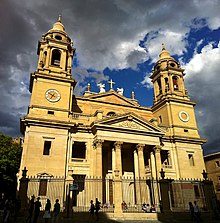Pamplona Cathedral
| Cathedral of Saint Mary the Royal Catedral de Santa María la Real |
|
|---|---|

Pamplona Cathedral
|
|
| Basic information | |
| Location | Pamplona, Spain |
| Geographic coordinates | 42°49′10.93″N 1°38′27.57″W / 42.8197028°N 1.6409917°WCoordinates: 42°49′10.93″N 1°38′27.57″W / 42.8197028°N 1.6409917°W |
| Affiliation | Roman Catholic |
| Rite | Roman |
| District | Archdiocese of Pamplona y Tudela |
| Country | Spain |
| Ecclesiastical or organizational status | Cathedral |
| Architectural description | |
| Architectural type | Church |
| Architectural style | Neoclassical, Gothic |
The Pamplona Cathedral (Santa María la Real) is a Roman Catholic cathedral in the archdiocese of Pamplona, Spain. The current 15th century Gothic church replaced an older Romanesque one. Archaeological excavations have revealed the existence of other two previous churches. The Neoclassical façade was designed by Ventura Rodríguez in 1783. It has a 13th-14th-century Gothic cloister, that gives access to two other Gothic rooms: the Barbazan chapel and the refectory. The Mediaeval kings of Navarre were crowned there and some of them were also buried. The Navarrese Cortes (Parliament) was held there even during the early modern ages.
The site of the cathedral is the oldest part of the Roman Pompaelo. Archaeological excavations in 1994 have revealed streets and buildings from the 1st century BC. The oldest cathedral was demolished in 924 during the invasion of Abd-al-Rahman III, Caliph of Cordoba. During the reign of Sancho III (1004–1035) the church was reconstructed. That church was demolished from 1083 to 1097, and the Romanesque cathedral was built from 1100 to 1127. It collapsed in 1391, with only the façade remaining. The building of the current Gothic church began in 1394 and lasted to 1501. The floorplan is cruciform with ambulatory, a central nave and four shorter aisles, all covered by partially polycromed rib vault. The style is very influenced by French models.
...
Wikipedia
